 Ivana Lotoshynski, CFP®
Ivana Lotoshynski, CFP®
People Wealth Matters
Financial Advisor
https://peoplewealthmatters.com
ilotoshynski@peoplewealthmatters.com
Monthly Market Insights | December 2024
U.S. Markets
U.S. Markets
Stocks notched solid gains in November as post-election enthusiasm and holiday shopping combined to fuel the advance.
The Dow Jones Industrial Average led, gaining 7.54 percent. The Standard & Poor’s 500 Index picked up 5.73 percent, while the Nasdaq Composite added 6.21 percent.1
“The most serious mistakes are not being made as a result of wrong answers. The truly dangerous thing is asking the wrong questions.”
Peter F. Drucker, management consultant, educator, and author
Post-Election Rally
Despite a jittery start to November, stocks rallied following Election Day results and gained momentum following the Federal Reserve’s second consecutive interest rate cut. An economic update that showed a 2.2 percent rise in third-quarter productivity helped support the move.2,3,4
The combination of news pushed the S&P 500 to cross the 6,000 mark, while the Dow breached 44,000 for the first time.5
A Mid-Month Breather
After all three major averages hit record highs, markets took a breather as investors anxiously awaited fresh inflation data. News that retail and wholesale prices ticked up slightly in October sent markets down, even though both numbers were in line with economists’ expectations.6
Stocks remained under pressure after unexpected comments from Fed Chair Powell, who said the Fed wasn’t “in a hurry” to cut rates. Similar comments from another Fed official seemed to reinforce Powell’s sentiment and put additional pressure on stocks.7
Holiday-Shopping Optimism
But year-end optimism, especially around consumer spending during the holiday shopping season, re-started the rally. News that weekly jobless claims fell to a seven-month low also boosted momentum.8
Despite the headwinds from the Fed about rate adjustments, tough talk on tariffs and a handful of disappointing Q3 reports from technology companies, the S&P 500 and Dow Industrials each posted their best monthly gain of the year.9
Sector Scorecard
All S&P 500 sectors were positive in November. Financials (+10.46 percent) and Consumer Discretionary (+12.91 percent) led, with Communications Services (+6.91 percent), Energy (+7.83 percent), and Industrials (+7.59 percent) not far behind. Utilities (+3.78 percent), Real Estate (+4.17 percent,) and Consumer Staples (+3.87 percent) also showed up with solid returns. Technology (+5.17 percent), Materials (+1.49 percent), and Healthcare (0.37 percent) posted more modest gains compared with the S&P 500.10
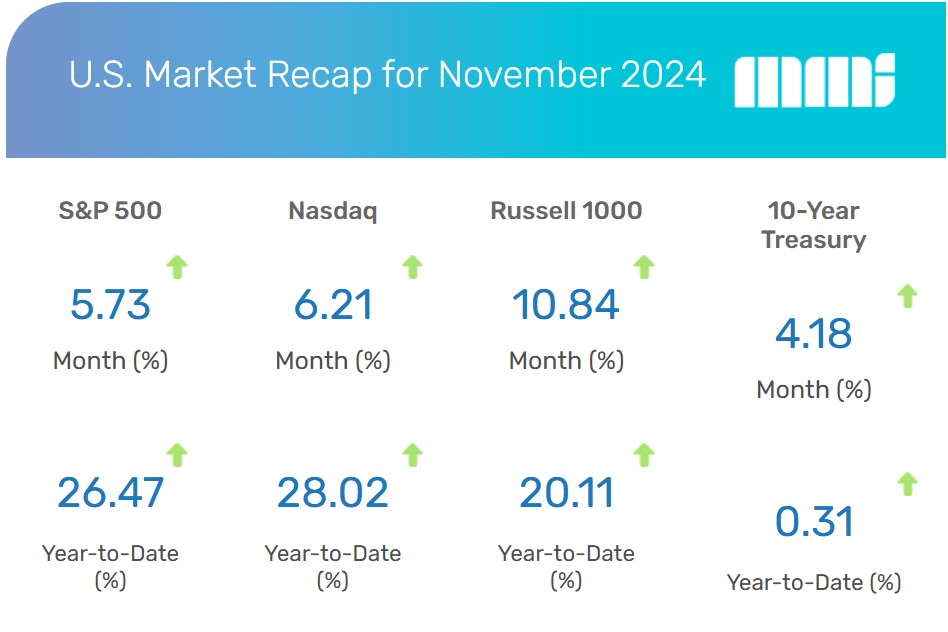
Yahoo Finance, November 30, 2024. The market indexes discussed are unmanaged and generally considered representative of their respective markets. Individuals cannot directly invest in unmanaged indexes. Past performance does not guarantee future results. U.S. Treasury Notes are guaranteed by the federal government as to the timely payment of principal and interest. However, if you sell a Treasury Note prior to maturity, it may be worth more or less than the original price paid.
What Investors May Be Talking About in December
In the month ahead, investors will most likely be monitoring a wide range of economic reports for clues about the Fed’s thinking.
Specifically, investors will be watching holiday spending. A solid holiday shopping season can suggest a strong economy, which may prompt the Fed to reconsider its position on rate adjustments as it pursues its dual mandate of stable prices and maximum employment.
Also, expect any report on the jobs market to be scrutinized. Some recent numbers have been influenced by the anomalous effects of hurricanes and a worker strike in September, which may have influenced the final numbers. The Fed has a variety of weekly and monthly reports on the state of the jobs market.
The Fed’s next scheduled two-day meeting ends on December 18. Fed Chair Powell has repeatedly said the Fed’s decisions are data-dependent, so all economic reports can factor into rate adjustment talks.
World Markets
The MSCI EAFE Index fell 0.74 percent in November, in stark contrast to U.S. averages that benefited from a post-election rally.11
European markets were mixed. The United Kingdom rose 1.35 percent, and Germany picked up 2.88 percent. Meanwhile, Italy lost 3.64 percent, while France dropped 1.57 percent. Spain was flat (-0.27 percent).12
Emerging markets were also mixed. Egypt fell 0.52 percent, while India added 0.52 percent.13
Pacific Rim stocks were generally lower. Japan’s Nikkei and China’s Hang Seng were among the hardest hit. Australia was a bright spot, picking up 3.38 percent.14
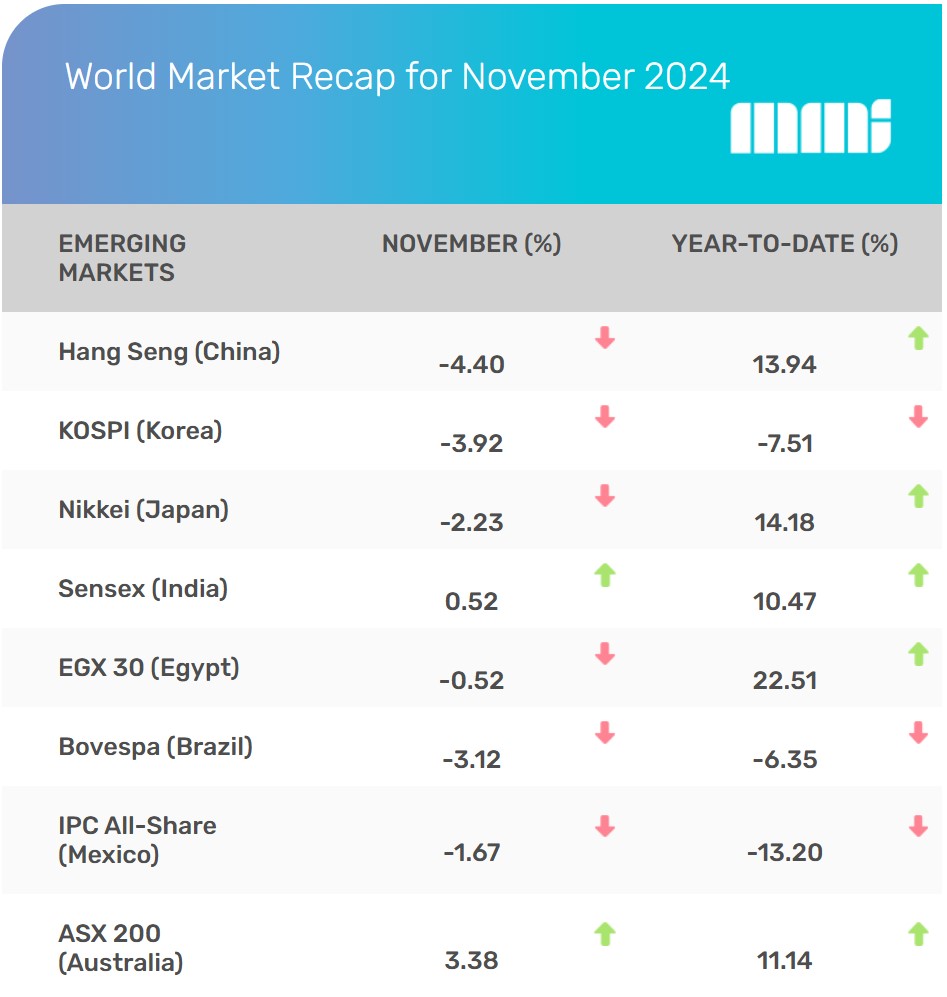
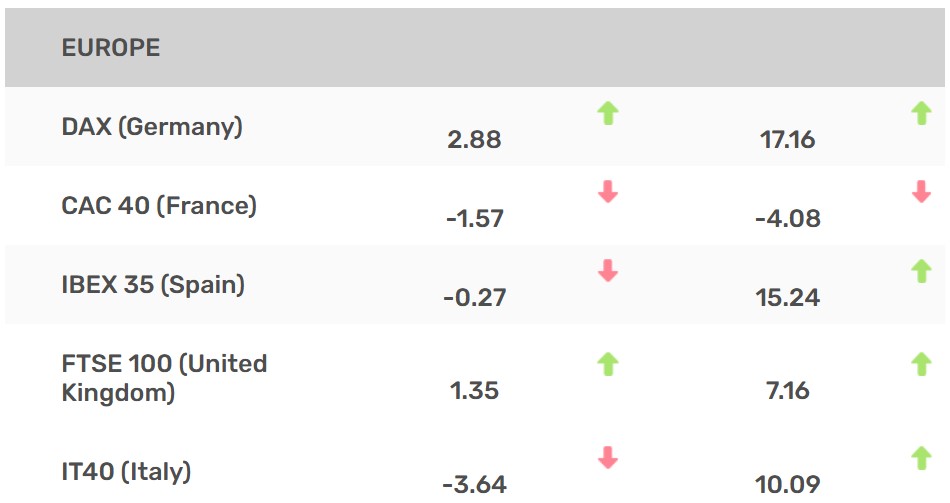
Yahoo Finance, November 30, 2024. The market indexes discussed are unmanaged and generally considered representative of their respective markets. Individuals cannot directly invest in unmanaged indexes. Past performance does not guarantee future results. International investments carry additional risks, which include differences in financial reporting standards, currency exchange rates, political risks unique to a specific country, foreign taxes and regulations, and the potential for illiquid markets. These factors may result in greater share price volatility.
Indicators
Gross Domestic Product (GDP)
The economy grew at 2.8 percent on an annualized basis in Q3, which was in line with economists’ expectations. While third-quarter GDP was below Q2’s 3.0 percent pace, it was still more than double the Q1’s 1.3 percent growth.15
Employment
Employers added 12,000 jobs in October, a drop from September’s revised 223,000 job gain. Economists had expected 100,000 new jobs created last month, considering the impact of two East Coast hurricanes and a worker’s strike at one of the largest U.S. aircraft manufacturers. Unemployment remained unchanged at 4.1 percent–in line with expectations.16
Retail Sales
Retail sales rose 0.4 percent in October over the prior month—slightly more than expected.17
Industrial Production
Industrial output fell by 0.3 percent in October–the second consecutive month of declines. The effect of the hurricanes and the workers’ strike dragged on output.18
Housing
Housing starts fell 3.1 percent in October, hitting its lowest level since July. The dip was driven by lower single-family starts, especially in the South and Northeast regions.19
Sales of existing homes rose 3.4 percent in October, higher than economists expected, as tentative home buyers came off the sidelines to take advantage of a brief dip in mortgage rates and improved inventory. The median existing home sales price was $407,200, a 4 percent increase from a year prior.20
New home sales fell 17.3 percent in October after a strong September. Year over year, new home sales were down 9.4 percent. The median new home sales price in October was $437,300, 4.7 percent higher than the previous year. There were 481,000 unsold new homes on the market, representing 9.5 months of inventory—up from 7.7 months in September.21
Consumer Price Index (CPI)
Consumer prices rose 0.2 percent in October over the prior month and 2.6 percent from a year earlier—a slight increase from September’s 2.4 percent year-over-year increase. Both numbers were in line with economists’ expectations, but they highlighted the bumpy road to the Fed’s 2 percent inflation goal. Core CPI, which excludes food and energy, grew 3.3 percent on an annualized basis—unchanged from September’s core reading. Core inflation was in line with expectations.22
Durable Goods Orders
Orders of manufactured goods designed to last three years or longer rose 0.2 percent in October, slightly below consensus expectations of 0.5 percent. Both civilian and defense aircraft orders rebounded sharply in October, contributing to the rise in overall durable goods orders.23
The Fed
The Federal Reserve cut short-term interest rates by 0.25 percent following its November meeting, bringing the benchmark Fed Funds Rate target range to 4.5 percent to 4.75 percent. At Fed Chair Jerome Powell’s post-meeting press conference on November 7, he signaled less certainty on the pace of future rate adjustments. He explained the ongoing need to weigh the risks of a resurgence in inflation and a cooling labor market.24
The FOMC’s next meeting is scheduled for December 17-18.
By the Numbers: Trends in Charitable Giving
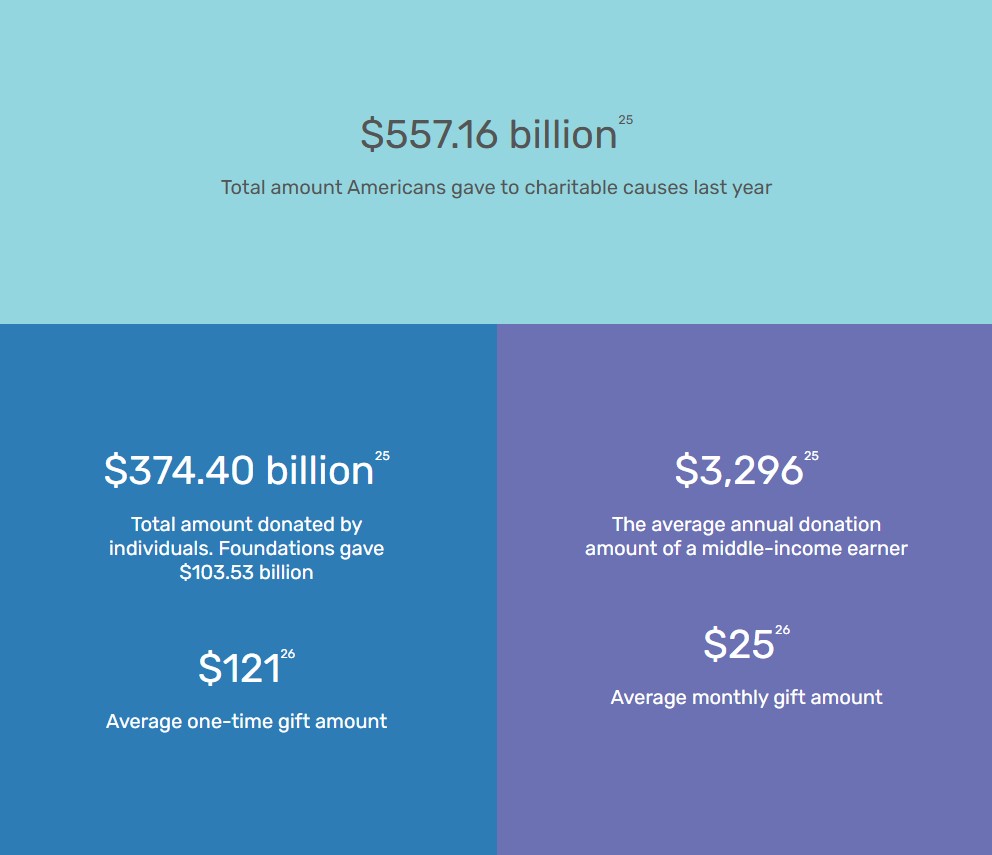
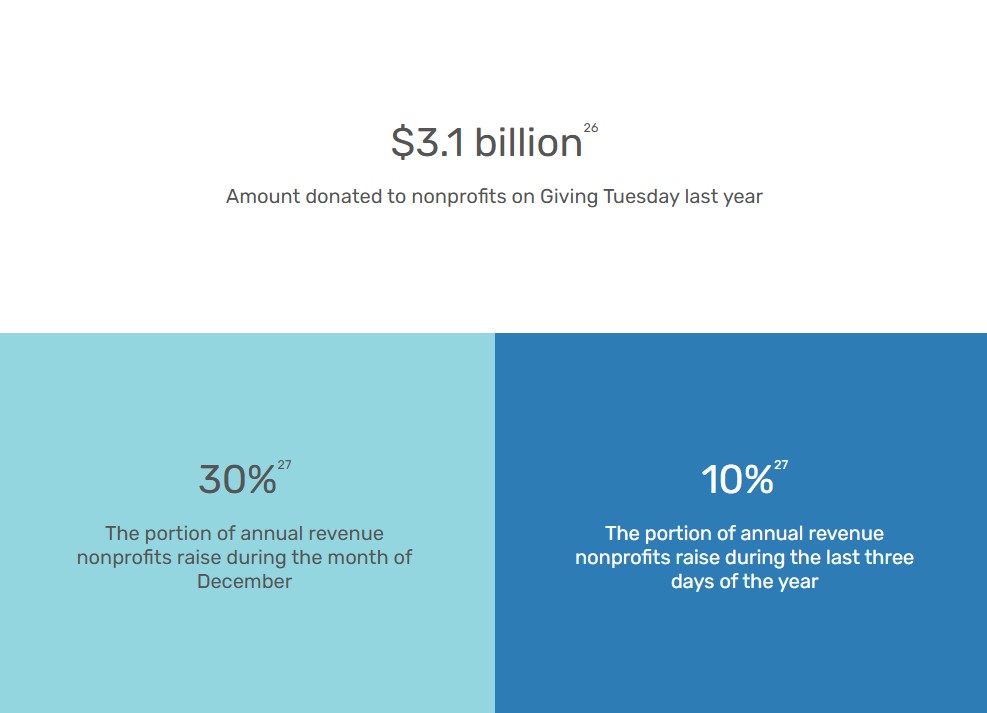

The content is developed from sources believed to be providing accurate information. The information in this material is not intended as tax or legal advice. Please consult legal or tax professionals for specific information regarding your individual situation. This material was developed and produced by FMG Suite to provide information on a topic that may be of interest. FMG Suite, LLC, is not affiliated with the named representative, broker-dealer, or state- or SEC-registered investment advisory firm. The opinions expressed and material provided are for general information and should not be considered a solicitation for the purchase or sale of any security.
Investing involves risks, and investment decisions should be based on your own goals, time horizon and tolerance for risk. The return and principal value of investments will fluctuate as market conditions change. When sold, investments may be worth more or less than their original cost.
Any companies mentioned are for illustrative purposes only. It should not be considered a solicitation for the purchase or sale of the securities. Any investment should be consistent with your objectives, timeframe, and risk tolerance.
The forecasts or forward-looking statements are based on assumptions, subject to revision without notice, and may not materialize.
The market indexes discussed are unmanaged and generally considered representative of their respective markets. Individuals cannot directly invest in unmanaged indexes. Past performance does not guarantee future results.
The Dow Jones Industrial Average is an unmanaged index that is generally considered representative of large-capitalization companies on the U.S. stock market. The S&P 500 Composite Index is an unmanaged group of securities considered to be representative of the stock market in general. The Nasdaq Composite is an index of the common stocks and similar securities listed on the Nasdaq stock market and considered a broad indicator of the performance of stocks of technology and growth companies. The Russell 1000 Index is an index that measures the performance of the highest-ranking 1,000 stocks in the Russell 3000 Index, which is comprised of 3,000 of the largest U.S. stocks. The MSCI EAFE Index was created by Morgan Stanley Capital International (MSCI) and serves as a benchmark for the performance in major international equity markets, as represented by 21 major MSCI indexes from Europe, Australia, and Southeast Asia. Index performance is not indicative of the past performance of a particular investment. Past performance does not guarantee future results. Individuals cannot invest directly in an index. The return and principal value of stock prices will fluctuate as market conditions change. And shares, when sold, may be worth more or less than their original cost.
International investments carry additional risks, which include differences in financial reporting standards, currency exchange rates, political risks unique to a specific country, foreign taxes and regulations, and the potential for illiquid markets. These factors may result in greater share price volatility.
The Hang Seng Index is a benchmark index for the blue-chip stocks traded on the Hong Kong Stock Exchange. The KOSPI is an index of all stocks traded on the Korean Stock Exchange. The Nikkei 225 is a stock market index for the Tokyo Stock Exchange. The SENSEX is a stock market index of 30 companies listed on the Bombay Stock Exchange. The Jakarta Composite Index is an index of all stocks that are traded on the Indonesia Stock Exchange. The Bovespa Index tracks 50 stocks traded on the Sao Paulo Stock, Mercantile, & Futures Exchange. The IPC Index measures the companies listed on the Mexican Stock Exchange. The MERVAL tracks the performance of large companies based in Argentina. The ASX 200 Index is an index of stocks listed on the Australian Securities Exchange. The DAX is a market index consisting of the 30 German companies trading on the Frankfurt Stock Exchange. The CAC 40 is a benchmark for the 40 most significant companies on the French Stock Market Exchange. The Dow Jones Russia Index measures the performance of leading Russian Global Depositary Receipts (GDRs) that trade on the London Stock Exchange. The FTSE 100 Index is an index of the 100 companies with the highest market capitalization listed on the London Stock Exchange.
Please consult your financial professional for additional information.
Copyright 2024 FMG Suite.
1. WSJ.com, November 30, 2024
2. WSJ.com, November 6, 2024
3. WSJ.com, November 7, 2024
4. MarketWatch.com, November 7, 2024
5. WSJ.com, November 8, 2024
6. WSJ.com, November 13, 2024
7. WSJ.com, November 14, 2024
8. MarketWatch.com, November 21, 2024
9. WSJ.com, November 29, 2024
10. SectorSPDR.com, October 31, 2024
11. MSCI.com, November 30, 2024
12. MSCI.com, November 30, 2024
13. MMSCI.com, November 30, 2024
14. MSCI.com, November 30, 2024
15. Reuters.com, November 27, 2024
16. WSJ.com, November 1, 2024
17. The Wall Street Journal, November 15, 2024
18. Reuters.com, November 15, 2024
19. KPMG.com, November 19, 2024
20. WSJ.com, November 21, 2024
21. Realtor.com, November 26, 2024
22. The Wall Street Journal, November 13, 2024
23. KPMG.com, November 27, 2024
24. The Wall Street Journal, November 7, 202425. NPTrust.org, 2024
26. DonorBox.org, September 18, 202427. DoubletheDonation.com, 2024




